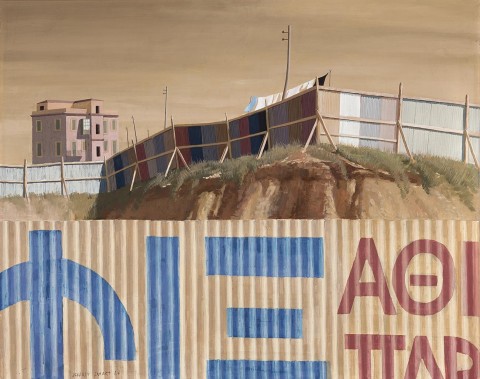OUTSKIRTS, ATHENS, 1964
JEFFREY SMART
oil on composition board
65.5 x 82.5 cm
signed and dated lower left: JEFFREY SMART 64
inscribed with title verso: OUTSKIRTS ATHENS
Macquarie Galleries, Sydney
Private collection, Sydney
Christie’s, Melbourne, 2 May 2002, lot 70
Private collection, Sydney
Jeffrey Smart, Galleria 88, Rome, 8 – 23 April 1965, cat. 9
Exhibition of Paintings, Jeffrey Smart, Macquarie Galleries, Sydney, 29 September – 11 October 1965, cat. 10
Quartermaine, P., Jeffrey Smart, Gryphon Books, Melbourne, 1983, cat. 454, p. 109 (dated as 1965)
Capon, E., et al., Jeffrey Smart: Drawing and Studies 1942 – 2001, Australian Art publishing, Melbourne, 2001, fig. 8, pp. 70 (illus., dated as 1965), 202
Study for Outskirts, Athens, 1965, ink and watercolour on paper, 15.5 x 23.0 cm, illus. in Capon, E., et al., Jeffrey Smart: Drawing and Studies 1942 – 2001, Australian Art publishing, Melbourne, 2001, cat. 68, p. 70
The geometry of Jeffrey Smart’s paintings is so cleverly conceived that it invites the eye to feel as well as see. And so it is with Outskirts, Athens, 1964, immaculately crafted with rectangles and curves, horizontals, verticals and diagonals. The corrugations of the iron fence contrast with the flatness of the cubic apartment block and look so man-made against the crumbling earth embankment. It is a classic Smart, superbly composed, painted, flat and textured, ever masterly in the handling of light and sharp-edged shade. Moreover, there is that magic touch of the cinematic, a still from the movies – enigmatic. Writing about the 1965 Macquarie exhibition in which Outskirts, Athens was introduced to Sydney audiences, James Gleeson described Smart as ‘… a narrative painter who deliberately refrains from telling a story. Instead he paints a “still” and leaves us to construct a sequence around it’.1 To this he adds a particular liking for repetition as in the seemingly endless curves of rhythmic corrugation. The same 1965 Sydney exhibition included another striking variation of repetition, of steps ascending in the painting E.U.R I., 1964 in the collection of the Newcastle Art Gallery, New South Wales.
Part of the genius of Smart is his ability to dress up the familiar as a new experience.2 He spent the summer of 1964 in Athens followed by six months on the island of Skyros. The stay in Athens ‘provided enough material for the whole Skyros period’.3 Curiously, the fences and line of washing in Outskirts, Athens were based not on a Greek scene, but a Roman view, specifically the ink and watercolour study, Porta Portese, Rome.4 Athens, as we all know, is the home of the Parthenon, one of the world’s greatest architectural achievements. That Smart should look instead to the fringe of its urban wasteland adds to the painting’s irony and wit. And does the washing evoke any notion of being hung out to dry, of abandonment of someone in need? Smart’s comment on the environment is given an extra twist by painting the sky an unnatural muted colour, empty and full of portent. Sky blue is featured prominently instead in the large lettering across the front fenced picture plane.
These truncated words and letters add further to the visual feast and its critique of the modern world in which we fail so miserably to communicate effectively. Smart sites this in today’s Athens, birthplace of democracy, and once the centre of great oratory.
The more super realistic Smart’s paintings appear, the more subtle are their innuendoes. As James Gleeson observed in 1965: ‘Smart preserves a façade of objectivity even when he is being most subjective’.5 While the front and backsides of the tin fences in Outskirts, Athens are regimented in an informal way and nature is quite fenced in, the leading electricity pole is not quite straight. Smart’s autobiography, published in 1996 and dubbed a ‘wicked and utterly engaging memoir’, is titled Not Quite Straight.6
1. Gleeson, J., ‘Jeffrey Smart’s “still” lifes’, Sun-Herald, Sydney, 3 October 1965, p. 76
2. Thornton, W., ‘Jeffrey Smart’s Exhibition’, Sydney Morning Herald, Sydney, 29 September 1965, p. 21
3. Quartermaine, P., Jeffrey Smart, Gryphon Books Pty Ltd, Melbourne, 1983, p. 20
4. Capon, op. cit., p. 70, which also refers to the same study being used for other works including the painting The Plastic Tube, 1980.
5. Gleeson, op. cit.
6 Not Quite Straight: a memoir, William Heinemann Australia, Melbourne, 1996
DAVID THOMAS
